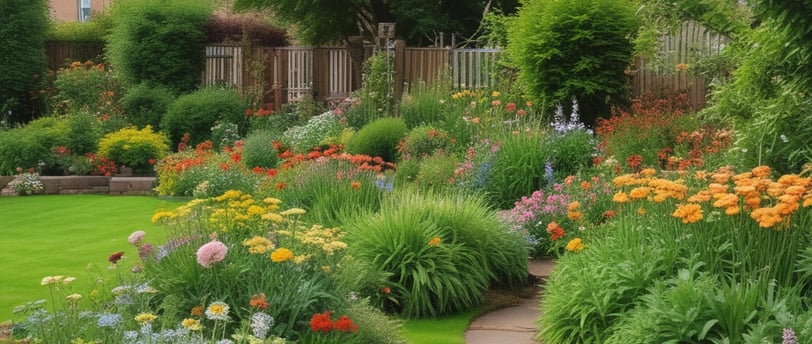Essential Garden Maintenance Tips for Wishaw Homeowners
Essential Garden Maintenance Tips for Wishaw Homeowners" is a comprehensive guide designed specifically for those facing Scotland's unique climate challenges. This post details actionable strategies—from seasonal clean-up, smart watering, and soil preparation to proper pruning and gutter care—to help you create a thriving, resilient garden. Learn how to choose native plants, manage excess moisture, and protect delicate flora during frosty winters, ensuring your outdoor space remains lush and inviting all year round. Whether you're an experienced gardener or just starting out, discover expert tips and a seasonal maintenance schedule that will transform your garden into a beautiful retreat.
2/27/20256 min read


Introduction
Gardens are not only an extension of your home but also a personal retreat where nature meets nurture. For homeowners in Wishaw, Scotland, the challenges of garden maintenance are unique. The local climate, characterized by cool summers, damp winters, and occasional frosts, requires a tailored approach to gardening. In this comprehensive guide, we share essential tips that will help you keep your garden vibrant, healthy, and resilient throughout the year.
Whether you’re a seasoned gardener or just starting out, our detailed maintenance checklist and practical advice will help you overcome common issues and create an outdoor space that reflects both beauty and functionality.
Understanding the Local Climate
The Scottish Weather Factor
Wishaw experiences a temperate maritime climate with relatively mild summers and cool, wet winters. This means that your garden faces challenges such as:
Excess moisture: Leading to fungal diseases and root rot.
Cool temperatures: Slowing down plant growth and making seasonal transitions crucial.
Frost and freeze cycles: Which can damage tender plants if not properly protected.
Knowing your local weather patterns is the first step toward effective garden maintenance. Adjusting your watering schedule, fertilization, and plant selection to match these conditions can make all the difference.
Seasonal Considerations
Spring: The season of rebirth. It’s the ideal time to clean up winter debris, prune damaged branches, and prepare the soil for new plantings.
Summer: Although relatively mild, summer in Wishaw can still bring sporadic heat. Ensure your garden stays hydrated and mulch is applied to conserve moisture.
Autumn: A critical time to prepare for winter. Planting bulbs, fertilizing, and protecting plants from early frosts are essential tasks.
Winter: Focus on safeguarding sensitive plants, reducing watering, and using covers or shelters for delicate species.
Essential Garden Maintenance Tips
1. Regular Cleaning and Weeding
Keeping your garden tidy is the foundation of good maintenance. Start by removing fallen leaves, twigs, and any debris that may accumulate during the autumn and winter months.
Weeding: Regularly inspect garden beds and lawns for invasive weeds. Weeds compete with your plants for nutrients and water, so it’s important to pull them out by hand or use eco-friendly herbicides.
Leaf Removal: In the autumn, rake leaves and either compost them or use them as mulch (after proper shredding) to enrich your soil.
Tip: Consider scheduling a “garden clean-up day” once every two weeks during the growing season to keep your outdoor space neat and productive.
2. Soil Health and Preparation
Healthy soil is the cornerstone of any thriving garden. In Wishaw’s often damp conditions, soil can become compacted, leading to poor drainage and root problems.
Aeration: Use a garden fork or aerator to gently loosen the soil. Aerating in early spring and again in the autumn helps improve water penetration and oxygen flow to plant roots.
Composting: Create your own compost using kitchen scraps, garden waste, and fallen leaves. A well-maintained compost pile provides rich organic matter that enhances soil fertility.
Mulching: Apply a 2-3 inch layer of organic mulch around plants to retain moisture, regulate soil temperature, and suppress weed growth. Mulch also gradually decomposes, adding nutrients to the soil.
Tip: Test your soil pH every couple of years. Wishaw’s soil can vary, and adjusting the pH with lime or sulfur can help your plants absorb nutrients more efficiently.
3. Watering Wisely
With Scotland’s high rainfall, overwatering can be just as detrimental as under-watering. The goal is to maintain soil moisture without creating soggy conditions.
Smart Irrigation: Use drip irrigation systems or soaker hoses to deliver water directly to the root zone, reducing evaporation and preventing fungal diseases.
Rainwater Harvesting: Install rain barrels to collect water from your roof. This sustainable practice not only reduces your water bill but also provides soft, naturally pH-balanced water ideal for your garden.
Seasonal Adjustments: In spring and summer, monitor rainfall and adjust your watering schedule accordingly. In winter, most plants need minimal watering—only during prolonged dry spells.
Tip: Water early in the morning to allow foliage to dry during the day, reducing the risk of fungal infections.
4. Pruning and Trimming
Pruning is vital for maintaining plant health and encouraging new growth. It also shapes your garden and prevents overcrowding.
When to Prune: Generally, prune in late winter or early spring before new growth begins. However, some shrubs and flowering plants may require summer pruning to remove spent blooms.
Tools: Invest in a high-quality pair of secateurs, loppers, and a pruning saw. Clean and sterilize your tools before use to prevent the spread of disease.
Techniques: Remove dead or diseased branches first. Then, focus on shaping the plant to allow light and air to penetrate the canopy. Avoid over-pruning, which can stress the plant.
Tip: Mark the date of your pruning sessions in a garden journal to track the growth and recovery of your plants.
5. Plant Protection and Winter Care
As the weather turns colder, it’s crucial to protect your garden from frost and freezing temperatures.
Frost Protection: Use horticultural fleece, cloches, or even old bedsheets to cover vulnerable plants during frosty nights. Remove the covers during the day to let sunlight in.
Bulb Planting: Autumn is the ideal time to plant spring-blooming bulbs like tulips, daffodils, and crocuses. Plant bulbs at a depth of three times their height for optimal growth.
Winter Mulching: Apply a thicker layer of mulch around perennial plants to insulate roots from freezing. Organic mulches, such as straw or shredded leaves, work well.
Tip: If you have potted plants, move them to a sheltered location like a porch or garage during extreme cold spells.
6. Gutter Cleaning and Exterior Maintenance
Maintaining your garden isn’t just about the plants—it also involves keeping the surrounding structures in top shape.
Gutter Cleaning: Regularly clean your gutters to prevent blockages caused by leaves and debris. Clogged gutters can lead to water damage on your home’s exterior and foundation.
Pressure Washing: Use a pressure washer (or hire professionals) to clean pathways, patios, and exterior walls. This not only improves curb appeal but also prevents the buildup of mold and algae in damp conditions.
Inspection: Check for cracks, peeling paint, and other signs of wear on outdoor structures. Timely repairs can prevent more extensive damage and save money in the long run.
Tip: Schedule gutter cleaning in the spring and fall. If you’re doing it yourself, use a sturdy ladder and proper safety gear to avoid falls.
7. Incorporating Local Flora
One of the best ways to ensure a low-maintenance, resilient garden is to plant native species that are well-adapted to the local climate.
Native Plants: Choose plants that naturally occur in Scotland. They typically require less water, are more resistant to local pests, and thrive in the regional soil.
Biodiversity: Incorporate a variety of plants, including shrubs, perennials, and grasses, to create a balanced ecosystem. Diverse plantings can help reduce the spread of pests and diseases.
Seasonal Interest: Plan your garden so that something is always in bloom, ensuring year-round beauty and providing habitats for local wildlife.
Tip: Visit local garden centers or botanical gardens for recommendations on native plants suitable for Wishaw.
Creating a Year-Round Garden Maintenance Schedule
Having a structured maintenance schedule is key to managing your garden effectively. Here’s a quick guide to help you plan your tasks:
Spring
Early Spring: Clear winter debris, inspect plants for damage, and begin pruning.
Mid-Spring: Aerate the soil and start composting. Plant new annuals and prepare beds for summer.
Late Spring: Set up drip irrigation if needed and mulch garden beds.
Summer
Early Summer: Monitor watering needs, trim and prune summer blooms, and weed regularly.
Mid-Summer: Maintain irrigation systems and check for pests. Clean outdoor structures if needed.
Late Summer: Prepare for autumn by deadheading spent flowers and planning for bulb planting.
Autumn
Early Autumn: Rake fallen leaves and clean garden paths. Begin planting bulbs and apply winter mulch.
Mid-Autumn: Protect delicate plants with frost covers and clean gutters.
Late Autumn: Finalize garden clean-up before the onset of winter. Check stored garden tools for repair.
Winter
Early Winter: Limit watering and focus on indoor plant care. Plan for the upcoming growing season.
Mid-Winter: Inspect outdoor structures periodically, especially after storms.
Late Winter: Begin preparations for spring by ordering seeds and planning garden layouts.
Conclusion
For Wishaw homeowners, maintaining a vibrant garden requires a combination of proactive care, local knowledge, and practical strategies. By understanding the unique climate challenges and following these essential tips, you can create a garden that not only enhances your home’s beauty but also provides a peaceful retreat from the hustle and bustle of everyday life.
Remember, successful gardening is all about consistent effort and timely maintenance. Keep a garden journal to track your tasks, successes, and lessons learned. With the right approach, your garden will flourish throughout every season, and you’ll enjoy a greener, healthier outdoor space year after year.
Happy gardening!
If you found these tips helpful, feel free to share your own garden maintenance stories or ask questions in the comments below. Stay tuned for our next post on “Preparing Your Garden for a Scottish Winter.”
